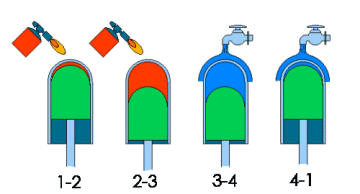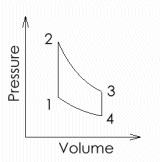 General discussion of Stirling Engine part 3
General discussion of Stirling Engine part 3 General discussion of Stirling Engine part 3
General discussion of Stirling Engine part 3The working principal of the Stirling engine and P-V diagram of Stirling cycle are shown in follows figure. The Stirling cycle is consisted by 4 thermodynamic processes; Isovolumetric heating process(on P-V diagram, descrived by 1-2) , Isothermal expansion process(2-3), Isovolmetric cooling process(3-4), and Isothermal compression process(4-1).


AnimationiThe browther JAVA(TM)1.1.X avairable is required.j
The heat wasted in the Isovolmetric cooling process(3-4) is equals supplyed heat in the Isovolumetric heating process. Therefore using the heat wasted in the Isovolmetric cooling process to the heat for the Isovolumetric heating process, by adopting regenerator, cycle's thermal efficiency became follows equation
![]()
Where Th is higher temperature and Tc is lower temperature.
This efficiency equals to efficiency of Carnot cycle, therefore Stirling cycle has the highest efficiency.
![]()
Copyright SUCTION GAS ENGINE MFG. CO., LTD. 1998
Send comments or requests to info@suction.co.jp